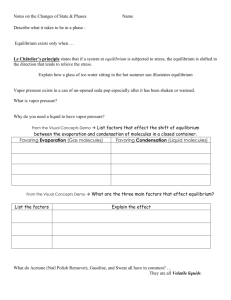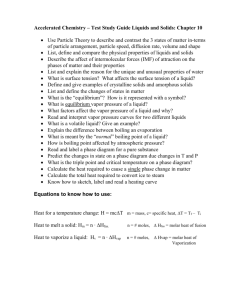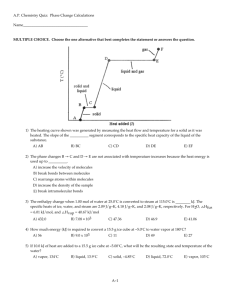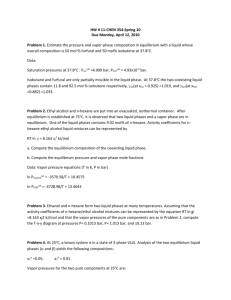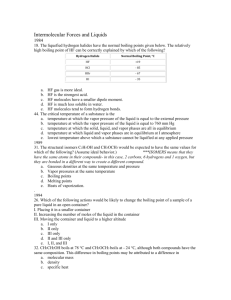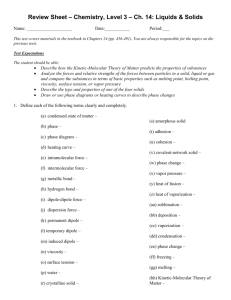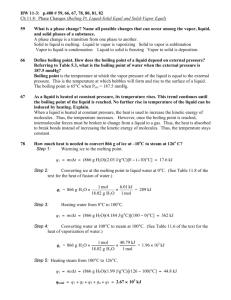Liquids and Intermolecular Forces
advertisement
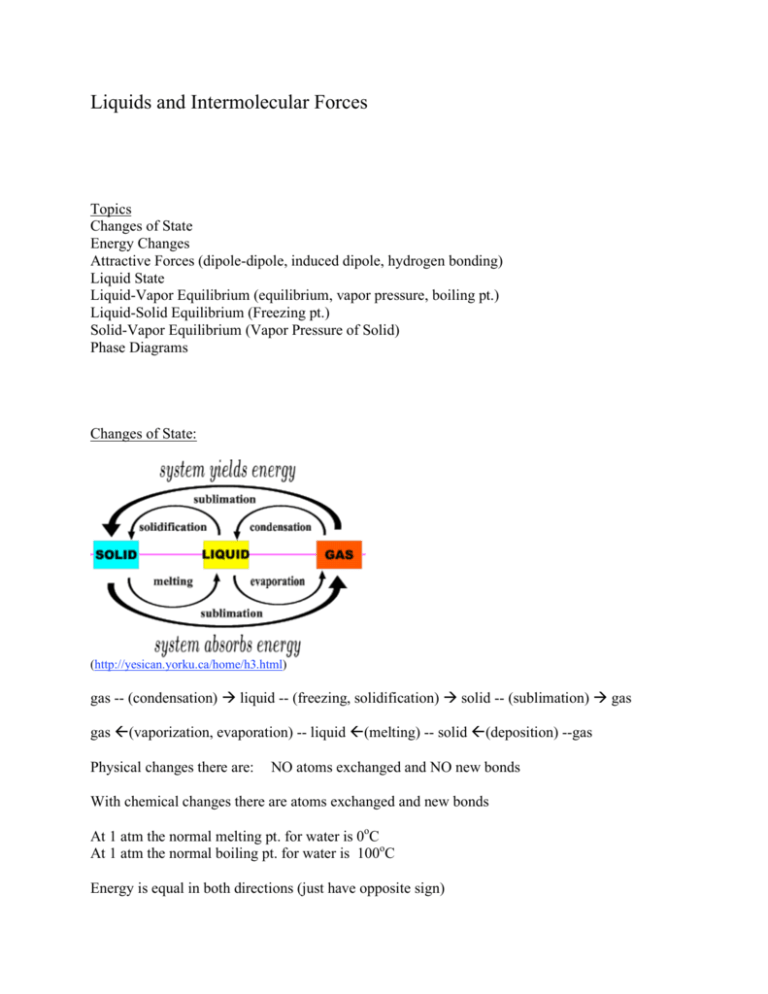
Liquids and Intermolecular Forces Topics Changes of State Energy Changes Attractive Forces (dipole-dipole, induced dipole, hydrogen bonding) Liquid State Liquid-Vapor Equilibrium (equilibrium, vapor pressure, boiling pt.) Liquid-Solid Equilibrium (Freezing pt.) Solid-Vapor Equilibrium (Vapor Pressure of Solid) Phase Diagrams Changes of State: (http://yesican.yorku.ca/home/h3.html) gas -- (condensation) liquid -- (freezing, solidification) solid -- (sublimation) gas gas (vaporization, evaporation) -- liquid (melting) -- solid (deposition) --gas Physical changes there are: NO atoms exchanged and NO new bonds With chemical changes there are atoms exchanged and new bonds At 1 atm the normal melting pt. for water is 0oC At 1 atm the normal boiling pt. for water is 100oC Energy is equal in both directions (just have opposite sign) Solid --> (endothermic) --> Liquid Solid <-- (exothermic) <-- Liquid (note: endothermic means it takes in heat) (note: exothermic means gives off heat) Independent of path Solid Liquid Solid Liquid Gas Body uses sweating (evaporation of water) Energy Changes Heat Capacity When Heat added to a substance the temperature increases except at phase change (melt, evaporate) and then energy is all going to change phase Heat needed to raise temperature by 1oC is called the heat capacity More substance the higher the heat capacity Can have heat capacity per mole or per gram Heat capacity of ice 2 J/ (g oC) = 36 J/(mol oC) molar Heat of Fusion (melting) put heat in solid liquid molar Heat of Solidification takes heat out liquid solid molar Heat of Vaporization puts heat in liquid gas Example: Bromine 0.5 mol from -7oC to 59oC Melt (10.5 kJ/mol)(.5 mol) = 5.25 Heat (0.76 kJ/mol oC)(66oC)(.5 mol) = 2.51 Vaporize (30.0 kJ/mol)(.5 mol) = 15.00/ 22.76 kJ (q = h m ΔT) (q = C ΔΤ) For Water +6.01 kJ - 6.01 kJ +40.7 kJ (http://www.saskschools.ca/curr_content/physics20/heat/latent_heat.htm) Attractive Forces between Molecules Instantaneous induced dipole --> Van der Waals Interaction London forces (dispersion forces) Shift in electronic charge distribution affects others (http://www.sparknotes.com/testprep/books/sat2/chemistry/chapter5section1.rhtml) Large molecules have larger electron clouds so more attraction Methane CH4 gas Pentane C5H12 liquid Candle Wax C18H38 solid He < Ne < Ar < Kr Dipole-dipole Polar molecules have higher melting and boiling points than expected for size Compound Dipole Melting Pt. Boiling Pt. HI .38 222 238 HBr .78 185 206 Less dipole then higher melting point because of London (dispersion) forces Hydrogen Bonding Compound H2O H2S CO2 Boiling Pt. 100 -60 -79 (http://www.wiley.com/legacy/college/boyer/0470003790/reviews/pH/ph_water.htm) Attraction between positive hydrogen and lone pair such as an O, F, N (strong electronegativity) Association between several water molecules causes the boiling and melting point to be very high NH3 and HF also hydrogen bond but H2O is most effective The larger the size of the molecule then the greater the London Forces therefore the higher the boiling point Exception: Hydrogen Bonding Liquid State Molecules close together so attraction holds together Pressure increase will only change volume slightly Increase in temperature will increase volume The molecular motion increases as a result (ex: thermometer) Diffusion in liquids much slower than in air because a lot more collision occurs Viscocity is measure of attraction of liquid molecules Surface tension holds liquids together in droplets or container (http://media.nasaexplores.com/lessons/03-048/images/) H2O Surface Tension Mercury Surface Tension (http://www.chem.purdue.edu/gchelp/liquids/tension.html) Cohesive force liquid to liquid (ex: water to water) Adhesive force liquid to solid (ex: water to the test tube) (http://faculty.clintoncc.suny.edu/faculty/Michael.Gregory/files/Bio%20101/Bio%20101%20Lectures/Chemistry/ch emistr.htm) Effects of Temperature and Pressure Low temperature and high pressure form liquid Above critical temperature gas cannot be liquefied no matter how high the pressure At equilibrium in a closed container some molecules will become vapor and some will become liquid Vapor pressure is pressure of gas of substance at equilibrium (http://www.epa.gov/eogapti1/module4/vaporpres/vaporpres.htm) Volatile evaporating readily at a normal temperature Stronger interaction between molecules then the lower the vapor pressure Relative humidity (pressure of water vapor/ vapor pressure of water) x 100 Note: In a closed container Superheating if bubbles don’t form sudden bump Use boiling chips as a surface for bubbles Liquid Vapor Equilibrium Evaporation is the change from liquid to gas Kinetic energy of liquid is the Maxwell Boltzmann curve Higher energy molecules leave first Temperature drops because remaining molecules have lower average kinetic energy (http://ibchem.com/IB/ibc/equilibrium/equ_htm/8.1.htm) Have to put more energy to keep liquid boiling Vapor Pressure Closed container equilibrium is reached H2O (l) <----> H2O (g) dynamic equilibrium Both vaporization and condensation are occurring Equilibrium vapor pressure (http://cougar.slvhs.slv.k12.ca.us/~pboomer/physicslectures/heat/vapor.html) (http://clem.mscd.edu/~wagnerri/Intro/dewclouds.htm) Equilibrium vapor pressure Normal atm 1.000 .836 .695 .0121 Boiling pt (oC) 100 95.1 90.1 10 Point 10,000 ft Liquid Solid Equilibrium (Freezing Pt.) Lower temperature the kinetic energy is low enough so intermolecular attractions hold crystal lattice Normal freezing pt. liquid <----> solid equilibrium at 1 atm of water Liquid --> solid molar enthalpy of crystallization = -6.02 kJ/mol (exothermic) Solid --> liquid molar enthalpy of fusion = 6.02 kJ/mol (endothermic) Vapor Pressure of a Solid Equilibrium between solid and vapor may be very low at ordinary temperature Phase Diagrams Temperature and Pressure regions where phases exist Pure substance (one component) (http://encarta.msn.com/media_461541579/Phase_Diagram_for_Water.html) At the critical point above this temperature gas cannot be liquifired Triple point is where solid, liquid and gas exist together One phase Two phases on line Three phases on triple point Water liquid more dense than solid (this is an exception from normal liquids) Exert pressure solid goes to liquid (ice skate on H2O) (http://www.colorado.edu/che/CLASSES/3320f/pages/liquification.html) Topics below covered in “Solids” Properties and Types of Solids Crystal Structure of Metals
